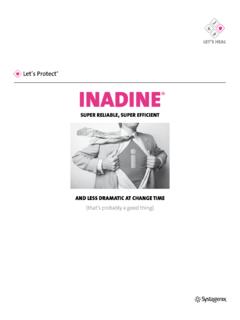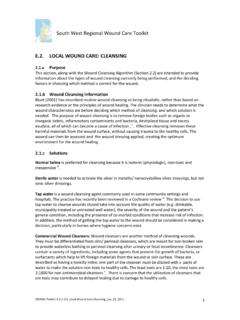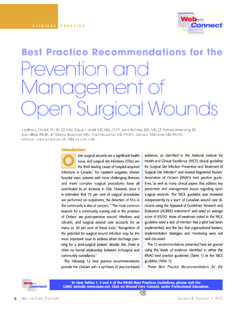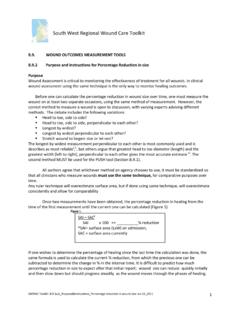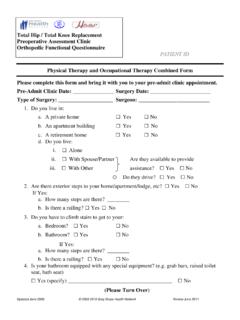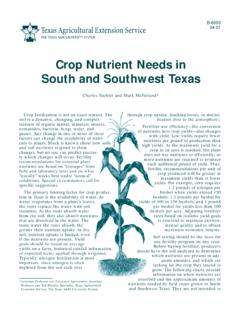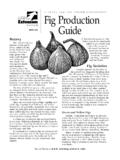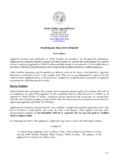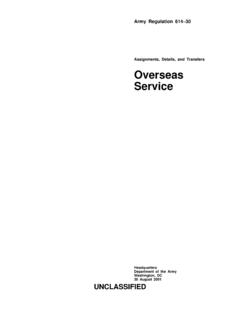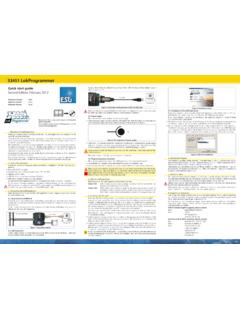Transcription of B.7. SIGNS AND SYMPTOMS OF WOUND INFECTION
1 south west Regional WOUND Care Toolkit SIGNS AND SYMPTOMS OF WOUND INFECTION The information appearing in these tablesi,ii,iii , iv,v,vi. (pages 1 3) has been derived from a variety of sources, including the validation of SIGNS and SYMPTOMS through bacterial assays, expert opinion via a Delphi technique and overview articles. They have been collated in order to provide one source for the multitude of SIGNS and SYMPTOMS of localized and spreading INFECTION in acute and chronic wounds. Documentation of the SIGNS and SYMPTOMS should be done using the charting system for WOUND assessment identified by each agency, institution or organization. Differentiating Between Local and Spreading INFECTION in Acute and Chronic Wounds i) Acute Wounds traumatic wounds, surgical wounds healing by primary intention including stitches, sutures, drains, and toe nail resection/extractionvii.
2 Acute Localized INFECTION Acute Spreading INFECTION Acute Wounds: All of the following (those in italics are also SIGNS of infected Acute Wounds: partial thickness and full thickness burns): As for localized INFECTION PLUS: Cellulitis Further extension of erythema Heat Lymphangitis (see definition in chronic Pyrexia in surgical wounds, typically five to wounds) seven days post surgery Crepitus in soft tissues Delayed (or stalled) healing WOUND breakdown/dehiscence Specific SIGNS of deep Abscess (under eschar in burns) incision SSI, affecting the fascia and muscle layers, or Malodour organ or space SSI, related to the procedure, which WOUND breakdown involves any part of the anatomy other than the Serous exudates with erythema incision that is opened or manipulated during the Specific SIGNS of superficial SSI Involves only skin and subcutaneous tissue surgical procedure which may occur within 30 days or around the incision, occurring within 30 days of the procedure, and have at within one year if implant in place, and have at least least one of the following criteria.
3 * one of the following criteria*: New or increasing pain* purulent drainage from the incision but not Erythema + induration (erythema purplish in colour in burns)* from the organ/space of the surgical site * Local warmth* a deep incision spontaneously dehisces or is Localized swelling + increased exudates* deliberately opened by a surgeon when the Purulent (under eschar in burns)/hemopurulent discharge* patient has at least one of the following SIGNS Organisms isolated from an aseptically obtained culture of fluid or or SYMPTOMS fever (>38 C), localised pain or tissue from the incision* tenderness unless the culture is negative* The incision is deliberately opened by a surgeon, unless the culture is an abscess or other evidence of INFECTION negative* involving the incision is found on direct The following are NOT considered superficial SSIs: examination or by histopathologic or radiological examination* Stitch abscesses (minimal inflammation and discharge confined to the points of suture penetration) diagnosis of a deep incisional SSI by a surgeon or attending physician* INFECTION of an episiotomy or neonatal circumcision site Validation: S&S of SSI have been validated for those items indicated with an asterisk*.
4 Action: Contact surgeon; obtain a swab for c&s using the Levine method (see C) for aerobic and anaerobicviii cultures and sensitivity (obtain health practitioner orders) to determine species of bacteria and sensitivities to antibiotic therapy. ii) Acute Wounds: Partial thickness and Full Thickness Burns Burns As above in italics plus: Burns: As for localized INFECTION PLUS: Increased fragility of skin graft Ecthyma gangrenosum ( INFECTION of the skin skin graft/ skin substitute rejection with involvement of viable tissue typically caused by Pseudomonas Black/dark brown focal areas of discolouration in burn aeruginosa. It presents as a round or oval Friable granulation tissue that bleeds lesion, 1 cm to 15 cm in diameter, with a Green discolouration of the subcutaneous fat halo of erythema. A necrotic center is Hemorrhagic lesions in subcutaneous tissue of burn WOUND or usually present) SWRWC Toolkit: SIGNS and SYMPTOMS of WOUND INFECTION and Differentiating_between_Local&Spreading_ Infections_inAcute&ChronicWounds_ 1.
5 Jun_27_2011 south west Regional WOUND Care Toolkit surrounding skin Necrotizing INFECTION / fasciitis Increase in size or depth of WOUND Secondary loss of keratinized areas Validation in Burns: Any SIGNS and SYMPTOMS need to be assessed by a health care practitioner as quickly as possible to determine if systemic antibiotics are warranted. Notes: Pain is not always a feature of INFECTION in full thickness burns Deep wounds induration, extension of the WOUND , unexplained increased white cell count or SIGNS of sepsis may be SIGNS of deep WOUND ( subfascial) INFECTION Immunocompromised patients SIGNS and SYMPTOMS may be modified and less obvious Sepsis documented INFECTION with pyrexia >39 c or hypothermia < c, tachycardia >110 beats per minute, tachypnoea >25 breaths per minute, raised or depressed white blood cell count INFECTION . SYSTEMIC. Severe sepsis sepsis and multiple organ dysfunction Septic shock sepsis and hypotension despite adequate volume resuscitation Death NB: Other sites of INFECTION should be excluded before assuming that systemic INFECTION is related to WOUND INFECTION Chronic Wounds diabetic foot ulcers, venous leg ulcers, arterial leg/foot ulcers or pressure ulcers, open surgical wounds including dehisced, infected, healing by secondary intention, WOUND closing by contraction and deposition of tissuevii.
6 Both chronic localized and chronic spreading infections involve SIGNS and SYMPTOMS beyond the classic SIGNS and SYMPTOMS of erythema, pain, swelling and heat. Chronic WOUND Infected with Biofilm Delayed (or stalled) healing ( WOUND not 20 to 30% smaller in 4 weeks according to patient history or existing documentation* (in spite of compression Rx with venous ulcers) occurring alone without other SIGNS & SYMPTOMS is indicative of biofilm INFECTION . Chronic Localized INFECTION Chronic Spreading INFECTION New, increased or altered pain* As for localised INFECTION PLUS: Delayed (or stalled) healing ( WOUND not 20 to WOUND breakdown/ increased size (length/ width or depth)* 30% smaller in 4 weeks according to patient Increase in temperature in surrounding skin (if thermoscan is history or existing documentation* (in spite of available, increased periwound margin temperature of more than compression Rx with venous ulcers) 3 F or C* Bleeding or friable (easily damaged) Erythema/ edema extending from WOUND edge* granulation tissue* Increased exudate (serous/ Purulent / sango purulent))))
7 * Distinctive malodour or sweet, sickening Wounds with exposed bone or probes to bone* odor*/ change in odour New areas of satellite breakdown beyond the original WOUND WOUND bed debris or discoloration (dark, dull and/or recurrence of wounds shortly after healing* red or grey/green, raw, red or salmon Unpleasant or sweet, sickening odor* discolouration with gelatinous texture) or Increased pain in an insensate diabetic foot slough and necrotic/ nonviable tissue* Cellulitis Increased or altered/purulent exudates* Crepitus, warmth, induration or discoloration Induration spreading into periwound area Pocketing of granulation/ bridging of Malaise or other non specific deterioration in epithelium (seen in chronic surgical wounds patient's general condition healing by secondary intent such as pilonidal Additional SIGNS specific to: sinus wounds) Venous ulcers: newly formed ulcers within the inflamed margins of Periwound oedema existing ulcer Additional SIGNS specific to: Diabetic Foot ulcers: Phlegmon (a spreading diffuse inflammatory process Arterial leg ulcers: Change in viscosity of exudates, with formation of suppurative/purulent exudate or pus), fluctuation of necrosis new or spreading, erythema in periwound tissues , blue black discolouration and hemorrhage (halo), bone or tendon tissue that persists with elevation of limb becomes exposed at base of ulcer, sinuses develop, spreading necrosis or SWRWC Toolkit: SIGNS and SYMPTOMS of WOUND INFECTION and Differentiating_between_Local&Spreading_ Infections_inAcute&ChronicWounds_ 2.
8 Jun_27_2011 south west Regional WOUND Care Toolkit Venous leg ulcers: Sudden appearance or increase in gangrene amt. of slough, sudden appearance of necrotic black Arterial leg and diabetic foot ulcers: Lymphangitis (inflammation of the spots lymphatic channels that occurs as a result of INFECTION at a site distal to the Pressure ulcers: Viable tissue becomes sloughy channel. Thin red lines observed running along the course of the lymphatic Diabetic foot ulcers: Ulcer base changes from healthy vessels in the affected area, accompanied by painful enlargement of the pink to gray nearby lymph nodes known as blood poisoning in layman's terms) Validation of SIGNS and SYMPTOMS in chronic wounds: INFECTION has been validated in the presence of three or more of the other SIGNS designated with an asterisk* Action: Assume that if three or more validated s&s are present, the WOUND is infected and obtain a swab for c&s using the Levine method (see C) for aerobic and anaerobic cultures and sensitivity (obtain physician orders) to determine species of bacteria and sensitivities to antibiotic therapy.
9 Notes In patients who are immunocompromised and/or who have motor or sensory neuropathies, SYMPTOMS may be modified and less obvious. For example, in a diabetic patient with an infected foot ulcer and peripheral neuropathy, pain may not be a prominent feature Arterial ulcers previously dry ulcers may become wet when infected Clinicians should also be aware that in the diabetic foot, inflammation is not necessarily indicative of INFECTION . For example, inflammation may be associated with Charcot's arthropathy. i Principles of best practice: WOUND INFECTION in clinical practice. An international consensus. London. MEP Ltd, 2008. Available from or ii Melling, A., Hollander, , & Gottrup, F. (2005). Identifying surgical site INFECTION in wounds healing by primary intention. EWMA Position Document: Identifying Criteria for WOUND INFECTION . London: MEP Ltd.
10 Iii Gottrup, F., Melling, A., & Hollander, (2005). An overview of surgical site infections : aetiology, incidence and risk factors. World Wide Wounds. Available at: Site infections . Accessed July 14, 2010. iv Cutting, , White, , Mahoney, P., & Harding, (2005). Clinical identification of WOUND INFECTION : a Delphi approach. EWMA Position Document: Identifying Criteria for WOUND INFECTION . London: MEP Ltd. v Woo, , Sibbald, (2009). A Cross sectional Validation Study of Using NERDS and STONEES to Assess Bacterial Burden Ostomy WOUND Management 55(8):40 48. vi Murray, C., & Hospenthal, (2008). Burn WOUND infections eMedicine. Available at: overview Accessed: July 15, 2010. x Landis, S., Ryan, S., Woo, K. & Sibbald, (2007) infections in chronic wounds. In: Krasner , Rodeheaver , Sibbald editors. Chronic WOUND Care Fourth Edition. Health Management Publications, Inc.
